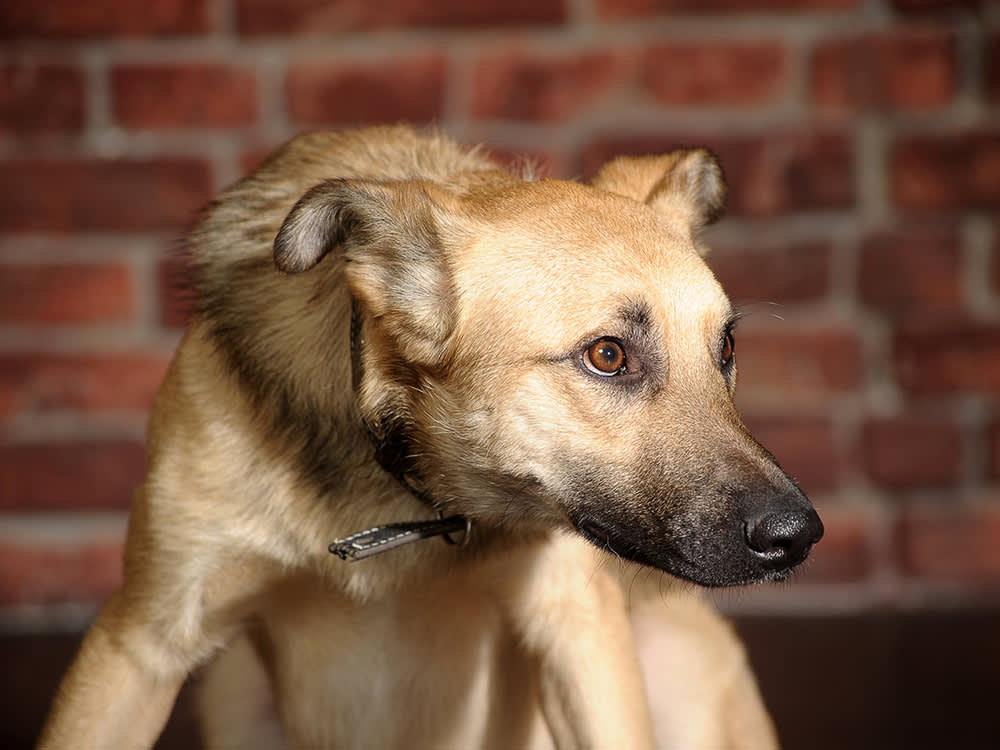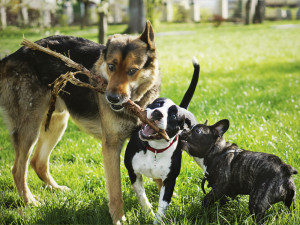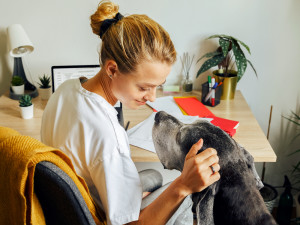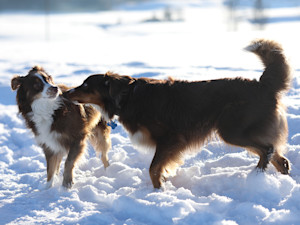Does Your Dog’s Growl Mean Aggression?
Remember, dogs have more than one emotion.

share article

Your pet wants you to read our newsletter. (Then give them a treat.)
Think of your dog’s behavior like you do grammar rules. Just as the words “there,” “they’re,” and “their” sound the same but mean different things (and definitely should not be used interchangeably), your dog’s body language and communication is complex.
For example, when dogs growl,opens in a new tab it is not always a sign of aggression; they may do so to ask something scary to back off, or they may do so while they’re having fun. Dogs pull when they are on the leash to get to a happy place as quickly as possible, or they pull to get away from a threat. They chew shoes, pillows, and toys because — well, they’re dogs. Or they chew a doorframe because they’ve been left home alone and are panicking.
In order to teach your dogs to do things such as walk politely rather than pull or chew an approved toy rather than a doorframe, you need to understand what your pet is trying to communicate and their emotional state. When fear and anxiety are at the root of the problem and you help your pup overcome them, the “bad” behavior goes away. Being able to tell how a dog is feeling can be challenging, so here are a few tips to get clued into what your dog’s body language is trying to tell you.
Are they taking an aggressive stance?
Let’s focus on what is probably the most inaccurately used adjective when it comes to describing dog behavior: “aggressive.” I’ve heard people use it when referring to a 10-week-old puppy who was playfully nipping the feet and legs of the children in the family. Most often, I hear people use it to describe a barking dogopens in a new tab. “How do you know he’s barking aggressively?,” I always ask. And the typical reply is, “Because he was barking.” Imagine if every time you spoke, someone assumed you were thinking about attacking them!
Let’s clear up the disconnect right now between what dogs do when they’re displaying signs of aggression and what they do when they’re just being dogs.
Signs of Aggressive Dog Body Language
Dog communication is mostly nonverbal; they “talk” with their bodies. Here are a few dog body language signals that could possibly indicate aggressive intent (if you observe any of the following, give the dog some space, at the very least):
Forward-leaning stance
Stiff body
Tail above the horizon, possibly stiff, possibly wagging
Ears up and forward (for cropped ears, look at the base of the ear)
Wrinkles or ridges around the eyes and lips
Direct stare
Raised hackles (hair along the dog’s back)
As you can see, when a dog is threatening aggression, his body tends to be stiff and forward. He may also bare his teeth, growl, or bark. Let’s compare this to a dog who has friendly intentions. A comfortable dog has a relaxed body that appears curved or wiggly (think puppy), soft eyes, with their tail below the horizon, often loosely wagging, ears relaxed, and mouth gently open.
Subtle Warning Signals
Dogs have powerful jaws and teeth that can do considerable harm to others, but it’s not in their best interest to go around biting people or other dogs. Fighting uses up a lot of energy, and they can be hurt or even killed as a result of engaging in it. So, rather than attack, dogs employ a vocabulary of escalating warning signals to ask the stressor to move away: hard stare, growl, bark, snarl, snap, and bite with inhibited force (meaning, they “pull their punch” and use reduced pressure).
If, after all of those warnings, the threat still has not moved away, a dog might then bite with full force. It’s important to note that dogs’ warning signals are very individual; some do all of them, some do a few, some bypass them altogether and go straight to the bite.
But an often overlooked factor—which could lead to aggressive behavior if ignored—is stress. It’s extremely important to know when your dog is showing signs of stress so you can remove him from the situation or help them cope with it.
Signs of Stressed Dog Body Language
Imagine you’re walking your dog in the park and a dog you’ve never met before approaches (we’ll assume both dogs are on leash). Don’t take it as a given that your dog will want to meet the other dog. Observe the dog’s body language to determine how they’re feeling about the situation.
Previously open mouth suddenly closes
“Dandruff” or dander appears
Tail risesopens in a new tab above the horizon
Yawning begins
Tongue flicks as if licking their lips
Turns entirely away from the approaching dog (or averts just eyes or head)
Starts scratching or sniffing
If your dog displays any of these behaviors, err on the side of caution. Respect what they’re telling you, which is, “I need some spaceopens in a new tab!” Move your dog out of the path of the oncoming dog and let them observe the strange dog at a stress-free distance. How will you know how far that is? Again, observe your dog and their body language will tell you. The stress behaviors will disappear, and you’ll see a noticeable softening or relaxing of their face and body.
One more important point to remember: Like human behavior, dog behaviors are fluid and can change in a blink of an eye. So when your dog is in a new situation, pay attention to what they are trying to tell you with their body language. With careful observation of dog body language, you can learn to “speak dogopens in a new tab” and keep your pet safe and happy.

Carin Ford, CPDT-KA
Carin Ford, CPDT-KA, is co-founder and president of DogsHome in Paoli, Penn.
Related articles
![Boston terrier being stubborn]() opens in a new tab
opens in a new tabDog Training — DIY or Hire a Pro?
When it’s time to call in reinforcements.
![Dog Lays On The Ground Barking]() opens in a new tab
opens in a new tabDog Speak: The Sounds of Dogs
Decoding the many sounds your pup makes.
![Pet parent comforting anxious dog by holding their paw]() opens in a new tab
opens in a new tab8 Tips for Helping an Anxious Dog
Easy ways to calm your pup’s nerves.
![Two Australian Shepherd dogs meeting in the snow]() opens in a new tab
opens in a new tabAre Your Dogs Arguing With Each Other?
How to tell the difference between dog aggression and communication.
![Dog with sleep startle reflex. Woman lays on her couch and gently wakes up her dog]() opens in a new tab
opens in a new tabWhy Does My Dog Freak Out When I Wake Them Up?
“Let sleeping dogs lie” is more than just a confusing old saying.








